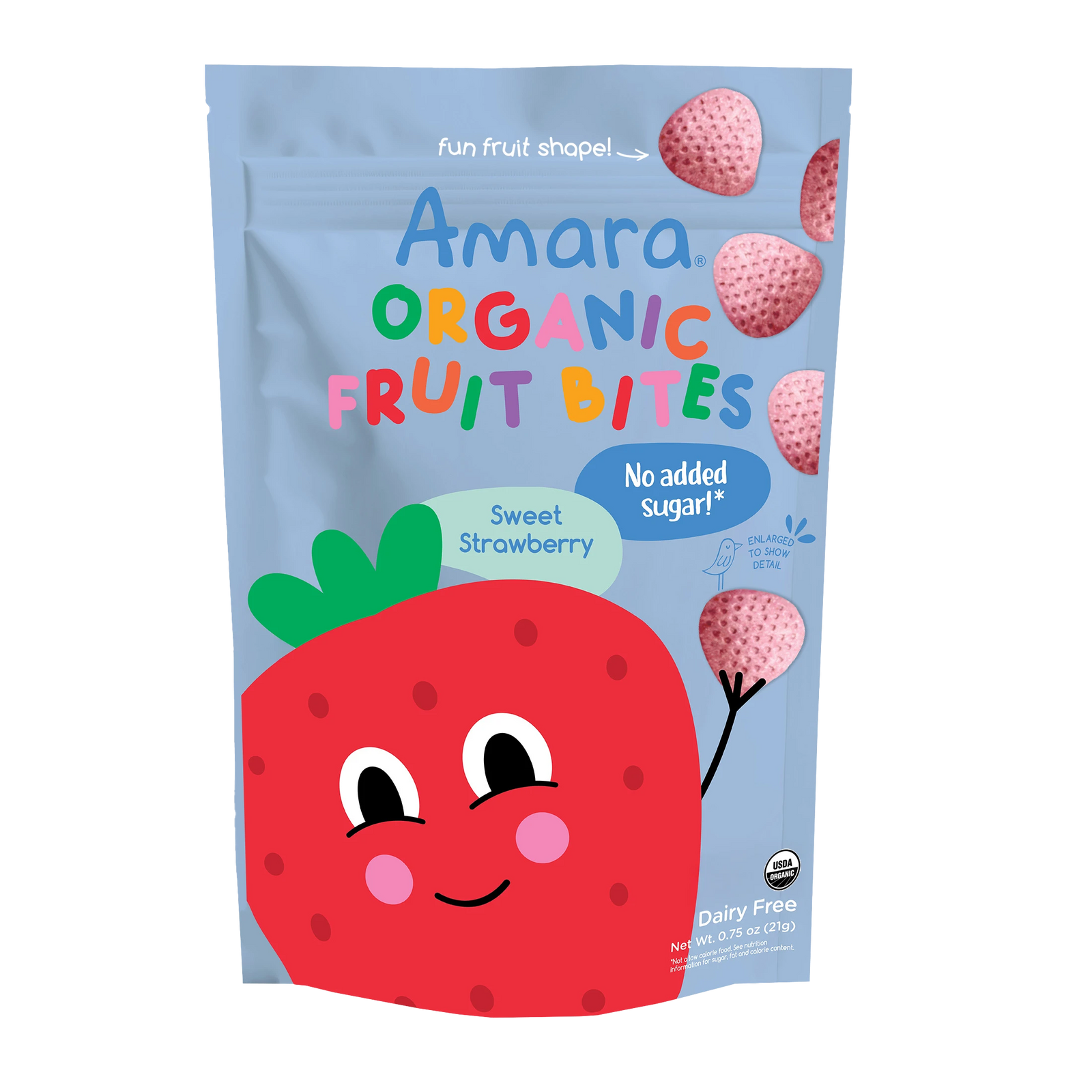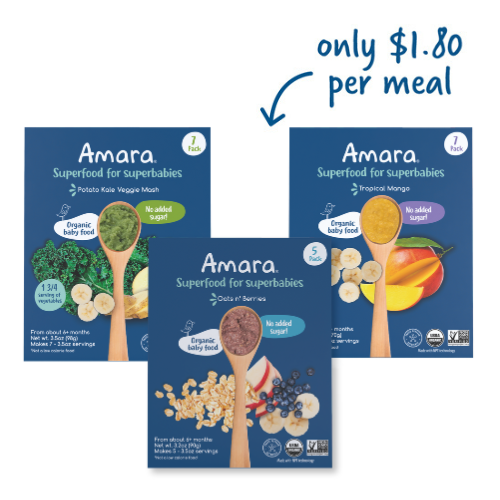A Deep Dive into Protein and the Best Combinations for Your Baby
By Sonia Schiess, Dietitian & Nutritionist PhD
We hear a lot about protein these days, from the benefits in babies and kids for their growth; to athletes for muscle strengthening; or to feeling satisfied when dieting. But did you know that in combination with certain foods, protein can actually be “fully” appreciated and improved in their overall quality?
Your diet today
Our diet today is made up of carbohydrates, fats and proteins. The macronutrient that is most consumed in our diets is carbohydrates. Natural foods that are most known for their valuable carbohydrates are mainly: potatoes, cereals, fruits, beans and some vegetables (like carrots, beets, butternut and peas). Another popular macronutrient that is consumed are fats. We like to speak of the "healthy" fats in vegetarian diets such as olives, avocados, nuts (walnuts, almonds), seeds or cereal germ. On the carnivorous side, animals that are most known for their fats are meat, fish and sausage. Milk, cream and cheeses also have a variable amount of fat.
The third macronutrient that is consumed in our diets today is protein. When you mention “protein” most people think of meat, fish, milk, egg and other dairy products. But did you know that you can also find high levels of protein in beans, nuts and cereals?
Generally, throughout the day you eat a variety of different foods that contain these three macronutrients (carbohydrates, fats, and protein) but in different levels.
Here at Amara, we recommend eating your food in its most natural, complete form possible. The best is always organic, local in in season. But, as that isn’t always possible for all of us – focus on trying to avoid elaborate processing or unnecessary production processes. Sounds complicated, what does that actually mean? It means you ideally consume the food as a whole food, not broken down by additional unnecessary processes that manipulate the food and generally degrade and /or separate the nutritional value it would bring to you in it’s pure form. The closest you can get to the original whole food (what nature grew), the best you can ensure that your body will get the vitamins, minerals, fibers and phytochemicals from the food. For example: Best eat the fresh avocado instead of the guacamole that comes in a jar with other seasonings and preservatives.
Protein
Today we’re concentrating on the protein; what is the protein, what does it do, why do we need it? One of the main functions of the protein is its part in creating structures like collagen, cells and muscles.
The base of our proteins are made with 20 amino acids; 9 of which are indispensable. Meaning we need to consume them.
Wait – take me back to science class - what are amino acids? Amino acids are basic structures of a protein and their key elements are carbon, hydrogen, oxygen, and nitrogen. The relationship of the amino acids presents for the formation of the protein needed by the body will define their quality. We need different amounts of each amino acid; the more similar the composition of the right amount of each amino acid to our requirements, the more protein can be built as body protein. This balance leads us to a better quality of protein. On the other hand, if one or two amino acids are present in a small amount, all the other amino acids will be less useful. In other words, the limiting amino acid doesn’t allow you reap the full benefits of the whole protein consumed.
Protein Quality Calculations
I know – nerdy right? If you don’t want to dive into the science, skim down to the recommendations of best protein combinations for your baby below. If you’re a food nerd, read on.
One way to calculate the quality of the protein is the biological value, which is measured from 1-100. This depends on the presence and the relation of the essential amino acids in the food. The whole chicken egg is taken as reference of 100 because its amino acid score is very similar to our body’s protein. In the following table you will see some biological values in different foods:
|
Food |
Protein Quality Value |
|
Chicken eggs |
100 |
|
Potatoes |
96 |
|
Cow’s meat |
88 |
|
Milk |
85 |
|
Beans |
60-80 |
|
Cereal |
60-70 |
|
Walnuts, almonds or seeds |
66-76 |
In other words, in these last foods there is at least one amino acid “limiting” so that it doesn’t reach a 100. There is at least 1 amino acid that is present in less quantity in comparison to the amino acid of the egg. Why is that important? Because this limiting amino acid doesn’t allow you reap the full benefits of the whole protein. That’s why we want to look at the different combinations to get you to the “full” protein.
You don’t normally eat one food alone for a meal, right? Your meal is usually made up of a combination of foods for a reason. Certain foods combined will complement the amino acid score and will reach higher levels of protein quality. Some good combinations:
Protein Combinations
Beans and Corn: Beans is a good source of protein but has a low level of the amino acid methionine. And corn, you guessed it. Corn has a lot of the amino acid methionine but is poor in lysin – which of course beans have enough of that amino acid. Together, they pair to make a good, high quality meal for our babies and kids.
Other good combinations:
Lentils with rice
Potato and egg
Milk and Wheat/rice cereals
Unlikely Sources of Protein
We’ve talked a lot about protein rich food and the protein quality of our food but we should not forget that these typical “protein – rich” foods also bring a lot of other valuable nutrients. For example, meat (like cow, calf or lamb) are great for iron. The iron in these foods is more easily absorbed in the body than the iron from vegetarian options.
Fish are a great source of protein but are also a great source of iodine, which is required for the synthesis of our growth-regulating thyroid hormones. Plus, fish high in fat is rich in omega 3 fatty acids. These are important for our cell membranes, blood flow and cardiovascular health.
Milk and other dairy products are known for protein, but are also a good source of calcium (important for building strong bones and teeth!)
Beans and cereals are also good sources of protein, especially if they are served together with beans or an animal based food. Beans and cereals are also sourced of Vitamin B, minerals and fiber among other things.
Protein and my baby
The weaning stage of baby feeding is considered to be from 6-24 months and has lasting effects on the health and development of a child. It can shape tastes later on in life and is an opportunity for the prevention of malnutrition as well as overweight and obesity.
Like everything, practice protein with your baby in moderation. On one hand, when your baby is starting solid foods you are worried about getting enough calories, protein, fat, vitamins and minerals in for your baby to ensure an optimal health and development; and on the other hand we are warning about overweight and obesity issues at a young age – what’s the link?
Is protein playing a role? Yes and no. Issues with overweight and obesity are often related to the unnecessary intake of sugar-sweetened beverages, fruit juices, sweet or savory snacks in the place of valuable foods. If we compare feeding habits in Europe for babies, the intake of energy providing liquids (fruit juice, tea with sugar, maltodextrin, etc.) shows lower intakes of formula and solids during the age of 6 to 12 months (Schiess et al 2010). This means that babies under 12 months old seem to exchange their calorie intake of formula and solid foods when they are offered sweet drinks or fruit juices. Solid foods and formula/breastmilk are what provides the valuable nutrients and create the feeding habits that shape our children’s health and growth. It’s important your baby has more real “food” than sweet drinks and fruit juices. Bottom line, stay away from the sugary drinks and juices when introducing solids to your baby.
One area that is being studied currently is the link between protein and obesity. There is increasing evidence that a high-protein intake during the first years of life results in an increased risk of obesity (Michaelsen et al 2017). This is still being studied but we mention this because it means that the right amount of protein for your baby is important.
How much protein should my baby eat?
There are different studies and recommendations on how much protein a baby will need for healthy growth. PJ Garlick recommends 1.43g protein/kg body weight at 6 months and 1.18g protein/kg body weight at 1 year (PJ Garlick2006). Right now, there is not sufficient evidence to indicate an upper limit of protein and milk intake.
In summary: protein is an important macronutrient which infants and adults need for their health and infants and children for their growth. The quantityand qualityof protein in each food is different. A lower protein quality food can be improved considerably with a good food combination. As you start the solid foods journey with our babies, Amara is here to help you learn the right combinations of macronutrients and understand how to feed your baby the best baby food and combinations of fruits and vegetables for healthy development.
Sonia Schiess







Leave A Comment